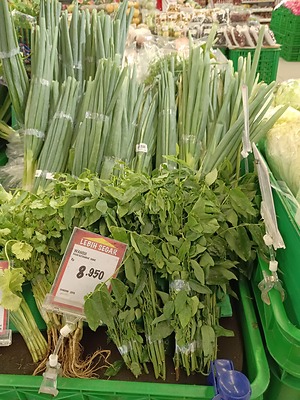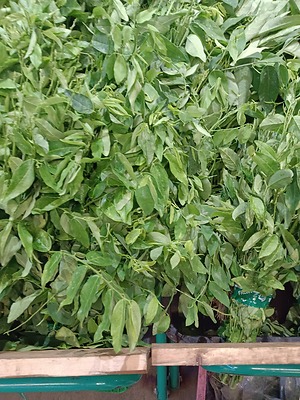


Sweet Leaves
Estimated Inventory, lb : 0
Description/Taste
Sweet leaves are a small to medium-sized varietal, averaging 1.8 to 6 centimeters in length and 0.6 to 4 centimeters in diameter, and have a lanceolate, elliptic, to oval shape with a curved, tapered nature ending in a distinct point on the non-stem end. The leaves grow in an alternate arrangement along the branches and are connected to the branch with short, flexible petioles 2 to 3 millimeters in length. Sweet leaves typically appear in shades of dark green to light green, depending on maturity, and have a thin, papery, and semi-smooth feel. One notable characteristic is white streaking on the leaf’s surface. The steaks can also appear more dotted, and some plants will have a lot of variation while others only have faint markings. Sweet leaves are said to be chewier than spinach, and only the young leaves, shoots, and tips are typically consumed in culinary preparations. It is recommended to use the top 10 to 12 centimeters of the young growth, and the greens have a subtly sweet, nutty, vegetal, and green taste reminiscent of a blend of fresh garden peas and asparagus. Sweet leaves have a mild, sweet, green flavor and offer a slightly acidic bite when cooked. It is important to note that Sweet leaves may be considered toxic if consumed in large, raw quantities. Should you have previous medical conditions or concerns, it is advised to discuss this plant with a healthcare professional before consuming raw. It is generally considered safe in moderation once cooked.
Seasons/Availability
Sweet leaves are available year-round.
Current Facts
Sweet leaves, botanically classified as Sauropus androgynous, are a tropical species belonging to the Phyllanthaceae family. The species is identified as a leafy shrub reaching 2 to 5 meters in height, but in cultivation, most plants are kept around 2 meters for easy harvest. The shrub is valued as a medicinal and culinary ingredient throughout tropical regions worldwide, and the young leaves, shoots, and tips are the most used portions. Sweet leaf is a name for the species primarily used in Singapore, Malaysia, Australia, and the United States. The species is also known under other regional names, including Mani Cai in Chinese, Chinese Malunggay in Filipino, Sayur Manis, Cekur Manis, and Sabah vegetable in Malay, Pak Waan in Thai, Amame Shiba and Ruridama-no-ki in Japanese, and Katuk in Indonesia. Sweet leaves are found wild and are also commercially cultivated, and growers favor the species for its high yields, fast-growing nature, and ability to thrive in hot, humid climates. In the modern day, Sweet leaves are an everyday culinary green treasured for their nutty, pea-like taste and are incorporated into a wide array of fresh and cooked preparations.
Nutritional Value
Sweet leaves are a source of iron to develop the protein hemoglobin for oxygen transport through the bloodstream, vitamin C to boost the immune system, vitamin E to reduce inflammation, and fiber to regulate the digestive tract. The leaves also provide vitamin A to maintain healthy organ functioning, copper to develop connective tissues, potassium to balance fluid levels within the body, magnesium to control nerves, calcium to build strong bones and teeth, and other nutrients, including vitamin K, zinc, manganese, phosphorus, and B vitamins. Sweet leaves are a medicinal ingredient in natural Southeast Asian remedies and are used for ulcers, bladder issues, diarrhea, and coughs. The leaves, fruits, roots, and flowers are also used to boost milk production among mothers, reduce fevers, and lessen heartburn.
Applications
Sweet leaves have a fresh, green, sweet, and nutty taste suited for raw and cooked preparations. Young leaves, shoots, and tips can be consumed raw in small quantities and are typically tossed into salads, used as an edible garnish or layered into sandwiches. Some consumers choose not to eat the species raw because they can become toxic in large quantities. In addition to fresh preparations, Sweet leaves are popularly simmered into soups and curries, steamed and mixed into rice dishes, or stirred into casseroles and pasta. The species can also be stir-fried with aromatics and served with meat as a main dish or rice as a side dish. Sweet leaves retain their dark green coloring when heated, and the leaves remain slightly chewy, giving them added texture over other cooked greens such as spinach. In Singapore, Sweet leaves are stir-fried with garlic, shallots, and peppers, cooked with eggs in scrambles and omelets, or chopped into dips. The leaves can also be battered and fried, a variation of tempura. Sweet leaves pair well with seafood, meats such as beef, pork, and poultry, aromatics including garlic, ginger, turmeric, onions, and shallots, and herbs such as cilantro, mint, and parsley. Whole, unwashed Sweet leaves should be immediately consumed for the best quality and flavor and will only keep for a few days when stored in the refrigerator’s crisper drawer.
Ethnic/Cultural Info
Sweet leaves were heavily debated in the late 20th and early 21st centuries on whether they were edible raw or considered poisonous. In 1995, companies in Taiwan began selling a Sweet leaf extract that was promoted for weight loss. Taiwanese consumers were mixing the extract with fruit juice and eating large amounts of fresh leaves to reduce hunger. After the extract’s release, many consumers became ill. Over 54 people suffered symptoms from taking the extract, and of the total numbers, around 50 were female and 4 were male. The main symptom expressed was lung issues, and several consumers experienced permanent lung damage. Scientists believe consuming high, concentrated quantities of raw Sweet leaves, specifically in extract form, may cause the lung tissue to become inflamed, leading to bronchiolitis obliterans, creating difficulty breathing. In 2005, another outbreak of lung issues was caused by consumers taking Sweet leaf supplements for weight loss in Japan. In review of these events, many articles and opinion-based blogs have been released with polarizing opinions on the edibility of Sweet leaves in their raw form. It has been generally agreed that raw leaves are considered toxic in high, concentrated quantities, but it in smaller amounts, some healthcare professionals claim they are fine, while others say they are dangerous. Regardless of opinions, Sweet leaves have been consumed raw in small quantities throughout Asia and Southeast Asia for thousands of years, and the leaves have been an important culinary and medicinal ingredient, so more research needs to be completed before an assessment can be made. Always consult with your primary physician before consuming raw Sweet leaves to ensure the greens are safe in relation to medical history and health conditions.
Geography/History
Sweet leaves are native to Southeast Asia and have been growing wild since ancient times. The species thrives in lowland, humid, and warm tropical forests and can be found in regions up to 1,300 meters in elevation. Sweet leaf shrubs are typically an understory plant and have been foraged for their leaves, shoots, roots, fruits, and flowers. Experts believe the species was first commercially cultivated in Sabah, a Malaysian state on Borneo Island, and over time, production spread throughout Southeast Asia, Asia, and Australia. Today, Sweet leaves are still predominately located in their native region and can be found at fresh markets in regions across Southeast Asia, specifically in Malaysia, Indonesia, Singapore, the Philippines, Vietnam, Thailand, and Laos. The species is also present in India, China, Japan, Taiwan, Sri Lanka, New Zealand, and in Florida, Hawaii, and parts of California in the United States.









